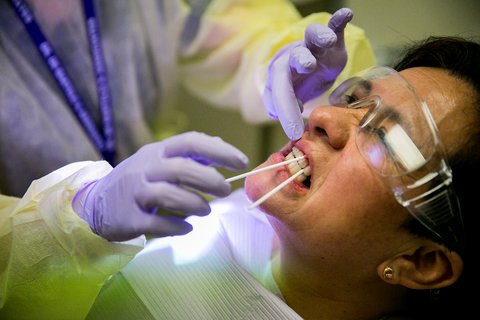Our Teeth Are Making Us Sick
The left side of Jacquelyn Garcia’s face throbbed fiercely. She had tried taking Tylenol and Excedrin for the pain, but threw them up.
On a Monday morning straight after working the night shift as a custodian, she rushed to the N.Y.U. emergency dental clinic. Here a student delivered the verdict: decay so deep it had reached the nerve. The tooth needed to be pulled.
Paradoxically, this could make her mouth worse off. Dentists say pulling a tooth can lead to a cascade of other problems: the teeth start shifting, the bone diminishes, the skin sags and the risk of gum disease increases. But Ms. Garcia didn’t have any choice. Her tooth had been rotting from the inside out for more than a year. She didn’t have dental insurance and didn’t want to pay the high fees until the pain had surged and she couldn’t stand it anymore.
As Americans debate medical coverage, the problem of our teeth has remained almost entirely unaddressed. About 114 million Americans don’t have insurance coverage for their teeth – more than twice the number of people who didn’t have health insurance before the Affordable Care Act.
“Oral health is a neglected issue nationally,” said Julia Paradise, an associate director of the program on Medicaid and the Uninsured at the Kaiser Family Foundation. “This is a big problem. The mouth and the head – mental health and dental health – somehow remain outside of what people think of as general health.”
Lots of people (including politicians) think of dental care as a luxury – pleasant, sure, but not vital. But that’s just not true, experts say. Gum disease can increase the risk of heart disease and diabetes, and among pregnant women it is correlated with lower birth weights for their babies.
“It’s a lot more than just having a pretty smile,” said Peter Polverini, a dean emeritus at the University of Michigan School of Dentistry. “It’s not uncommon that you wind up with people being hospitalized because they can’t afford care.” Emergency room visits for dental problems – when teeth are often too ruined to save — cost the U.S. health care system an estimated $1.6 billion a year.

It’s virtually an accident of history that dental care isn’t considered part of medical care. The medieval barber-surgeon used to attend to all the human ailments that required a knife: bloodletting, tooth extraction, shaving. In the 1840s in the United States, the heirs to the tradition wanted to become professionals; they didn’t want to keep wandering from town to town selling their services. They asked physicians at the Medical College at the University of Maryland if they would include dentistry in the medical coursework, but the physicians refused. Soon after the dentists opened a separate dental school nearby.
This “historic rebuff,” as some historians have called it, is the creation myth of modern dentistry. The central tension in the tale – the separation between doctors and dentists (and the health of the mouth and the health of the body) – continues to plague patients today.
Obamacare doesn’t require plans to include dental coverage for adults and Medicaid has no required adult dental benefits, so coverage varies widely state-by-state, and even year-to-year. In addition, more than 51 million people live in federally designated “dental professional shortage areas,” where there are simply not enough providers to cover the need, according to Mary Otto’s new book Teeth. In many places, Medicaid offers such skimpy reimbursements that dentists don’t want to participate.
Experts have long observed that people’s teeth both reflect and reinforce poverty.
“I’ve been a public health researcher for about 25 years. I’ve worked with a lot of different populations of people,” said Harold Pollack, a scholar of poverty at the University of Chicago. “One common element of every severely vulnerable population I’ve worked with is people always have bad teeth. And they have always borne a real stigma for that.”
In New York, non-profits, teaching schools, and clinics that receive federal money have popped up to fill the demand for care, but the result is a patchwork system.

At the N.Y.U. School of Dentistry, some patients suffer traumatic injuries, but others simply never had preventative care and have reached the point of emergency. Dr. Laurie Fleisher, the amiable director of urgent care, recalled seeing a sixteen-year-old girl who hadn’t been to the dentist in five years. She came to the clinic in terrible pain. Neither the mother nor her daughter had realized how bad the damage to the girl’s teeth was, and soon they were both crying.
“I have to turn away sometimes, walk out,” said Dr. Fleisher. “Because I cry.”
In attempts to cheaply stem tooth pain, patients sometimes make their problems worse. Dr. Fleisher said she regularly sees patients crush aspirin onto their gums, hoping to soothe their mouths; instead, it burns away the gum tissue.
At the Institute for Family Health clinic in Harlem, which receives federal funds to treat the uninsured, a couple described taking two buses and a train from Long Island to reach an affordable dentist.
Dentists at the Institute recently saw a 12-year-old girl with such swollen gums that they wrote a case study about her to teach other medical professionals. “Kate,” as they refer to her in the study, had dental troubles that were affecting nearly every aspect of her life. She weighed only 69 pounds, likely because she was drinking liquids to avoid chewing. She barely spoke and rarely participated in school; her mother said she was bullied.
In the South Bronx, Diana Cardona works as a dentist out of a giant blue truck, in a program run by the Children’s Health Fund and the Children’s Hospital at Montefiore. The program gets federal funds to serve poor communities.
“Can you fix this?” a woman once asked as she spat six crowns into her hand one by one.
Dr. Cardona sees patients who haven’t been to the dentist in decades, who tell her they don’t want to work in the front of the office, or talk to people, because they’re too humiliated by their teeth. They fear that rotting teeth will be seen as evidence of poverty, homelessness, or bad hygiene. (“My family’s distress over our teeth – what food might hurt or save them, whether having them pulled was a mistake – reveals the psychological hell of having poor teeth in a rich, capitalist country,” the essay is Sarah Smarsh wrote.)
Dentists and public health officials say ignorance and indifference are primary reasons dental care still isn’t included in general healthcare nationwide. Burton Edelstein, a professor at Columbia’s College of Dental Medicine, recounted a visit to lawmakers, seeking an adult dental benefit.
Lawmakers quickly rebuffed him, he recalled, saying in effect, “Dental doesn’t matter. Adults can take care of themselves.”
So the advocates tried again, pitching a dental benefit for disabled adults to the lawmakers. That didn’t work. Finally, they proposed something even more minimal: dental care for pregnant women. Lawmakers refused.
As Julia Paradise from Kaiser noted, “Unlike a lot of chronic disease where we’re still struggling with the science of how to prevent these diseases, we know how to do this in oral health. This is actually a problem we can solve.”
Source: kristof.blogs.nytimes.com
“Our Teeth Are Making Us Sick” by:Our Teeth Are Making Us Sick


